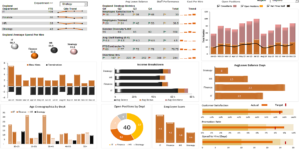
HR Strategies for Preventing Idea Theft and Keeping Employees Happy
In every workplace, new ideas help a company grow. Employees come up with great ideas to improve products, services, or how things are done. But sometimes, people might steal those ideas, making the person who came up with the idea feel upset or angry. This can harm the whole workplace. HR can help by taking action to stop idea theft and make sure everyone feels good at work. Here are some easy ways HR can do this: Encourage Open Communication HR should encourage employees to speak up and share their ideas without fear. If employees know they can talk openly, they won’t feel the need to hide their ideas. Regular team meetings or individual chats can help everyone feel comfortable sharing. Make Clear Rules About Ideas It’s important to have clear rules about who owns the ideas. An Intellectual Property (IP) policy should explain that any ideas shared at work belong to the company. This will prevent confusion and protect both employees and the business. Give Credit for Good Ideas When an employee’s idea leads to success, HR should make sure they get the credit. Recognising people for their ideas encourages them to keep sharing and shows that their contributions matter. Encourage Teamwork When employees work together, they’re less likely to steal ideas. HR should promote teamwork by organising activities where employees can share and build on each other’s ideas. This creates a more open environment where everyone can contribute. Use Non-Disclosure Agreements (NDAs) In some cases, HR might use legal agreements called NDAs to protect ideas. These agreements make sure that employees don’t share important company information or ideas outside the company. HR should explain these agreements clearly to employees. Provide a Way to Report Problems If an employee thinks their idea has been stolen, they should have a safe way to report it. HR should set up a simple system where employees can share their concerns without worrying about getting into trouble. This helps solve problems quickly and fairly. Offer Training and Growth Opportunities Employees are more likely to stay positive and keep sharing ideas if they feel supported. HR can offer training or opportunities for employees to grow their skills. This boosts morale and encourages employees to keep thinking of new ideas. Be Honest and Open HR should be clear about how decisions are made, especially when it comes to recognising new ideas. When employees understand the process, they’re more likely to stay motivated and feel valued. Build Trust Trust is key to a happy workplace. HR should make sure employees know how important it is to act honestly and treat others with respect. When trust is strong, employees will feel safe sharing their ideas without fear of them being stolen. Conclusion Preventing idea theft and keeping employees happy go hand in hand. By encouraging open communication, having clear rules, and recognising employees’ contributions, HR can protect both the company’s ideas and the morale of its workers. A fair and supportive workplace leads to more creative ideas, better teamwork, and happier employees.



